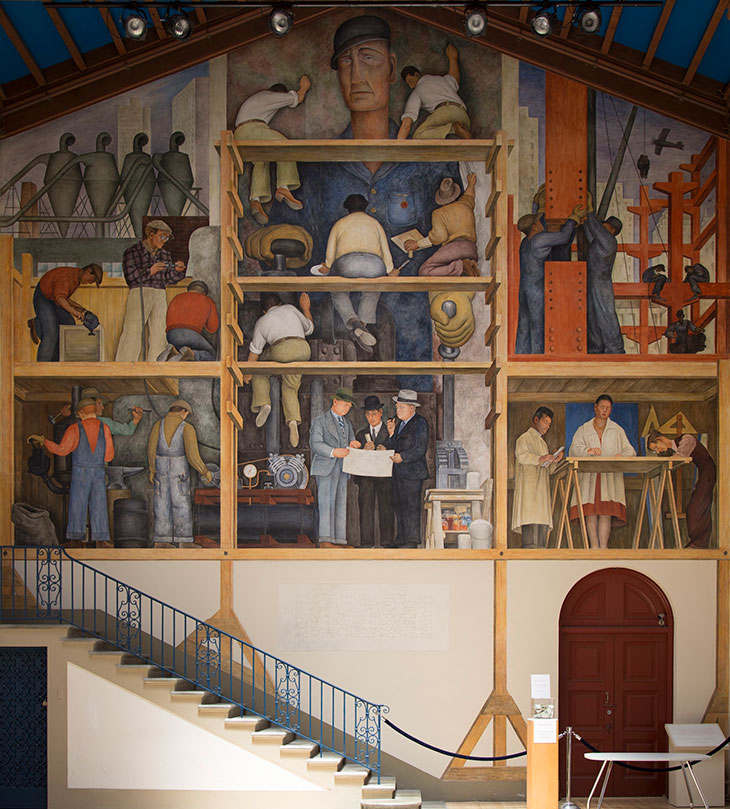This week the San Francisco Board of Supervisors voted unanimously to begin the process to confer landmark designation on Diego Rivera’s mural at the San Francisco Art Institute (SFAI), which would prevent its future removal. The mural, which is titled The Making of a Fresco Showing the Building of a City– and which the SFAI has reportedly considered selling to help cover its debts – was commissioned by the school’s president, William Gerstle, in 1930. The subject of this fresco within a fresco is the building of a modern industrial city and it pays tribute to the workers behind such projects, with a giant figure of a worker in blue overalls and helmet at the centre of the composition. Also depicted are the artist and assistants in the act of making the fresco, and some capitalist patrons who stand below Rivera’s trompe l’oeil scaffold.
The mural was completed in just one month, in May 1931 – unsurprising given the artist’s long working hours (often between 10 and 12 hours a day) and the nature of the fresco technique, which requires the artist to work against the drying time of the wet plaster and to apply paint in fast strokes (once the plaster has dried the paint is bound to the surface and it becomes very difficult to make corrections). To hasten the process Rivera hired assistants to prepare the plaster and grind pigments, and hand him refreshments throughout the day. The assistants were often local artists and muralists such as Victor Arnautoff and Lucienne Bloch. It was a choreographed spectacle that often attracted an audience who watched in awe.
Diego Rivera’s The Making of a Fresco Showing the Building of a City (1931), at the San Francisco Art Institute. Photo: courtesy SFAI

The mural continues to attract a flock of tourists and local residents and has been a key part of the SFAI’s identity for many generations, including mine. When I was an undergraduate student there in the early 1980s it brought memories of my upbringing in Mexico City (where I saw many of Rivera’s murals and his great collection of pre-Hispanic art at the Anahuacalli), and the mural is still the first thing that comes to my mind when I remember my time at the school. It can be found in the Diego Rivera Gallery, which in the distant past was once the cafeteria.
In its 150 years many internationally renowned artists have passed through the Diego Rivera Gallery, and the hallways of the SFAI. They were there as students (Annie Leibowitz, Paul McCarthy, Kehinde Wiley) and faculty (Mark Rothko, Ansel Adams, Dorothea Lange) as well as exhibiting artists, speakers and administrators. During my student days, the Diego Rivera Gallery was where I saw and participated in some of the wildest exhibitions I have ever seen. The opening receptions in the evenings were sometimes explosive, with rock bands playing in the courtyard outside the gallery, performances, and plenty of wine and beer.
Most memorable to me was a group exhibition with a political theme: ‘Artists’ Call: Against US Intervention in Central America’. The show was part of a national campaign organised by Central American poets and the art critic Lucy Lippard. For our contribution, we filled the walls from floor to ceiling with works including an inflatable sculpture of Reagan as a cowboy with his gun drawn above a neon text that read ‘Ray-Gun’. I remember a trustee telling us to ‘keep art out of politics’ (Rivera would surely not have approved) and I quoted the trustee in a large editorial cartoon created for the exhibition, showing Reagan and Kissinger as Mickey Mouse characters painting graffiti with blood. All this took place against the backdrop of Rivera’s mural. Perhaps some of the wild spirit of the school was inspired by the irreverence of the muralist, who positioned his own figure in the work so that his rear end would face the audience right at the centre of the composition.
The SFAI has long been in financial trouble but, like a phoenix, it usually rises from its ashes. Most recently it was rescued from foreclosure when in October the Regents of the University of California bought its $19.7 million debt from a private bank. The school has six years to pay off the debt, or allow UC to take possession of the campus – hence the floating of the proposal to sell the Diego Rivera mural. It is a heartbreaking situation that reflects the economic tragedy the country and the world are experiencing during the Covid-19 pandemic. Whatever happens, whether the mural is listed and whether it is sold or saved, I hope that Rivera’s work remains in place, with the school back in business.
Enrique Chagoya completed his BFA at the San Francisco Art Institute in 1984, where he received an honorary doctorate in 2017. He is a professor and head of art practice at the Department of Art and Art History at Stanford University.



